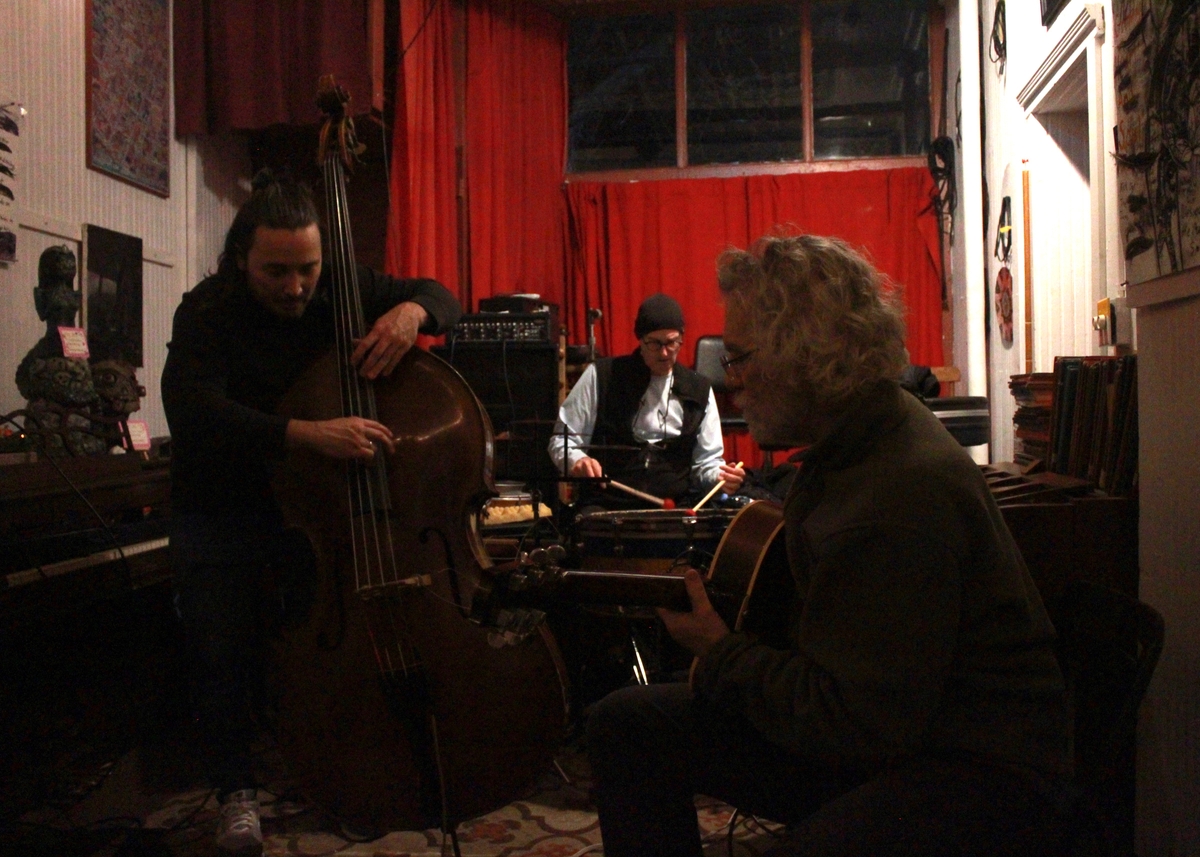
Brian Slattery Photos
Barrett, Deupree, Morris.
In between sets of improvised music at Never Ending Books on State Street, the band joked with each other with the ease of old friends. Ringleader Joe Morris introduced the band to newcomers. Horn player Taylor Ho Bynum used to live in New Haven, Morris said, but relocated to Vermont; shortly after his arrival, he got 40 inches of snow.
“And I stayed!” Bynum interjected, to laughter. Morris then introduced bassist Brad Barrett. “I don’t have any good snow stories about Brad,” Morris said. He was killing time. Seeing that most of the audience had settled in, he then turned to his fellow musicians.
“All right,” he said, “Enough reality.” And began to play.
The occasion was the latest in the Instantiation Music Series, held monthly at Never Ending Books, organized by guitarist Joe Morris, and featuring him and a rotating cast of musicians. Thursday evening featured Morris, Taylor Ho Bynum on cornet and flugelhorn, Brad Barrett on bass, and Jerome Deupree on drums, and it kicked off what will be a full weekend for improvised music across the Elm City. Tonight at Best Video will see Vance Provey, Dave Sewelson, Stephen Haynes, and Abbey Balgochian, with John Loggia, at 7 p.m., in addition to Firehouse 12’s jazz series, which night hosts Tom Guarna, with sets at 8:30 p.m. and 10 p.m. On Saturday, Firehouse 12 then hosts a night by the New Haven Improvisers Collective, featuring the Light Upon Blight Ensemble and the Roundhouse Quartet, at 8:30 p.m.
Born in 1955 and raised in New Haven, Morris is an internationally acclaimed free improviser, with an endless list of collaborators over the years that reads as a who’s who of the scene. He’s also a professor at the New England Conservatory of Music. But since returning to the New Haven area in 2001, he has helped foster the scene here, organizing concerts in New Haven, Hartford, and elsewhere at a variety of venues on a regular basis. The Instantiation Music Series is just the latest iteration.
In the first set, Morris began with pixellated notes on the guitar, sparse and confident. Barrett, Deupree, and Bynum all jumped on the idea, fleshing it out, building it up. Together the group climbed a ladder of energy to a first peak.

Bynum.
Then Morris dropped out, giving space to the other musicians. Bynum responded with bold, complex phrasing, and Barrett followed. Together they were off like a shot, with Deupree laying down the road for them to race on. Morris rejoined them and all the musicians played together again, making a collective sound like electricity caught in a circuit.
That was when Barrett introduced electronics into the band’s sound, getting chirps, blips, drones, and squawks out of his bass that could never be produced acoustically. Morris was ready, and together he and Barrett made a new soundscape. Bynum interjected with a long, forlorn line from his horn, and the whole mood of the music turned on a dime.
For a minute the band sounded like the theme to a film noir, smoky, alluring. Each musician used the comtemplative moment to explore tone. Barrett coaxed moans and wails out of his bass, while Bynum used a CD as a mute for his horn, producing a sound that was more buzz than note. It was distortion without needing an amp.
Deupree and Bynum then stepped back, musically, for Morris and Barrett to get chatty. They built up a frantic energy that Deupree leapt into. Bynum waited and waited, then sent a high, keening note over the top. For a minute the band kept at a breakneck pace, as if fast-forwarding through the history of bebop. Then a collective decision was made. The music stopped, and the audience applauded.
They started back in with a curt, sharply articulated phrase from Morris. The bass and drums echoed it, and soon they were engaged in a call and response, a conversation, while the horn sang elsewhere, exploring the edges of its sound.
Morris settled into an idea that conveyed more rhythm than anything else. That let Deupree off the hook to reallly dig in. He took advantage, coaxing metallic shrieks out of his apparatus while the conversation shifted. Bynum and Barrett enjoyed a lively musical exchange, the drums washing around them.
Morris had stopped played. He just listened, eyes closed, brow a little furrowed, hands off his instrument. Then he came back in with a phrase that split the difference between where he had ended and where the bass had traveled to. It was an injection of energy. Bynum twisted his clear notes into a sound like throttling seagulls. Bass, drums, and guitar now ricocheted off one another, each of them finding a place in the surging sound. For a minute, it almost sounded swampy New Orleans music in its tone and looseness, though the tonality was pure experiment.
Then Morris and Barrett took the floor, creating a new ensemble sound with electronics and the harder acoustic edge of what their instruments could do. Deupree gave the proceedings a precise pulse. Now they all relaxed fully, and the music became its noisiest yet, the drums like a rattle. Barrett made sounds of static, like a radio station trying to broadcast through a lightning storm,while Bynum sneaked in a distant, insistent melody. Everyone’s notes got longer. They were heading toward the same rhythmic pattern. Then the drummer intentionally fell off, the guitar and bass faded, and the horn ended on a long, mournful cry. The audience was nothing but smiles.
The next Instantial Music Series show at Never Ending Books, 810 State St., is on Jan. 18. Check Volume Two’s listings for more details and other programming in the State Street space.